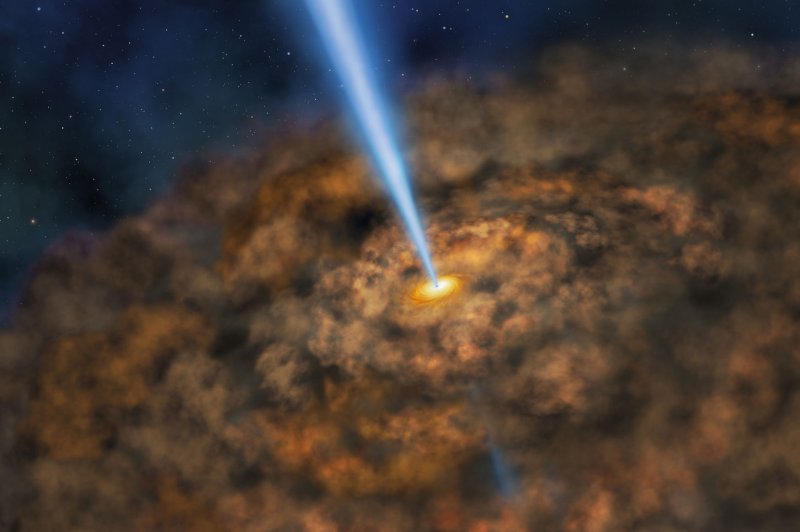New research suggests the stellar consumption rates of a black hole is linked with the radio jet emanating from its accretion disk. Photo by NASA/SOFIA/Lynette Cook/UPI |
License Photo
March 19 (UPI) -- Scientists have captured the radio signals produced by a black hole devouring a star -- a rarity.
In 2014, astronomers observed a tidal disruption flare, a burst of electromagnetic energy produced when a star was ripped apart by a black hole. Astronomers quickly redirected dozens of radio telescopes in the direction of the flare.
Analysis of the radio observations revealed the presence of a jet of high-energy particles. The radio signature closely matched the pattern of X-ray emissions, suggesting a close relation between the two phenomena.
"This is telling us the black hole feeding rate is controlling the strength of the jet it produces," Dheeraj Pasham, a postdoc in MIT's Kavli Institute for Astrophysics and Space Research, said in a news release. "A well-fed black hole produces a strong jet, while a malnourished black hole produces a weak jet or no jet at all. This is the first time we've seen a jet that's controlled by a feeding supermassive black hole."
When a black hole's gravitational forces trigger a tidal disruption event inside a star that wanders too close, the stellar material is flattened, ripped apart and pulled into the accretion disk. The phenomenon has been observed in optical, ultraviolet and X-ray bands, but less frequently in radio emissions.
X-ray emissions produced as a star is consumed by a black hole are thought to originate from the inner portion of the black hole's accretion disk, while ultraviolet emissions are produced in the outer rings of the disk. Astronomers have struggled to determine where radio emissions originate from.
"We know that the radio waves are coming from really energetic electrons that are moving in a magnetic field -- that is a well-established process," Pasham said. "The debate has been, where are these really energetic electrons coming from?"
Astronomers have previously hypothesized that a shockwave radiates outward as the back hole consumes the destroyed star, superheating surrounding plasma and producing radio emissions. If such a scenario were accurate, the radio signatures would be significantly different that those produced by X-ray emissions.
The latest research -- published Monday in the Astrophysical Journal -- contradicts such a theory.
Analysis of the 2014 tidal disruption event showed the X-ray observations and the radio emissions that were observed 13 days later were 90 percent similar.
"The only way that coupling can happen is if there is a physical process that is somehow connecting the X-ray-producing accretion flow with the radio-producing region," Pasham said.
Astronomers believe that as a radio jet forms inside a black hole's accretion disk, most of the radio waves are absorbed by surrounding electrons. But as the jet increases in size, radio waves are able to escape and be observed by telescopes. The phenomena suggests a strong correlation between the black hole's consumption rate and the strength of radio emissions.
The new analysis could help scientists build simpler and more accurate galactic evolution models. The feeding patterns of black holes have a significant impact on stellar production rates inside galaxies. As black holes consume stars and produce larger jets, high-energy particles and their heat can keep stellar material from condensing and forming new stars, altering the growth and evolution of galaxies.
"If the rate at which the black hole is feeding is proportional to the rate at which it's pumping out energy, and if that really works for every black hole, it's a simple prescription you can use in simulations of galaxy evolution," Pasham said. "So this is hinting toward some bigger picture."















